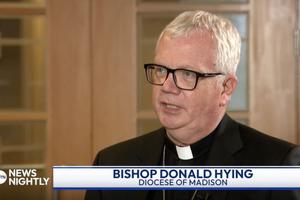Beauty of Eastern Catholic Tradition to Shine at National Eucharistic Congress
The diversity of Catholic liturgical expression is an oft-overlooked gem in the crown of the universal Church.

The National Eucharistic Congress is fast approaching. The Congress is scheduled for July 17-21 at Lucas Oil Stadium in Indianapolis. The event is part of the Church’s ongoing push to evangelize and catechize the faithful on the centrality of the Holy Eucharist to our walk of faith.
I have to admit that when this event was first announced, I had some negative preconceived notions. I feared that the Eastern Catholic liturgical traditions would not be represented and that the rich Eucharistic theology of the East would not be heard. Having benefited greatly from the Eastern Catholic theological and (especially) liturgical tradition in my own life, I wanted this tradition to be made more widely available via this national event. So, I reached out to the leadership of the Congress to see what they had planned to highlight the Christian East. To my great surprise and delight, they have so much in store.
I am pleased to share that there are scheduled Eastern Catholic liturgies every day of the Congress. The schedule follows:
- Thursday, July 18th at 4:00 PM — Byzantine Divine Liturgy with Bishop Bohdan John Danylo in the Indiana Convention Center Hall FG
- Friday, July 19th at 4:00 PM — Byzantine Hierarchical Vigil Divine Liturgy with Bishop Robert Pipta at St. Athanasius Byzantine Church
- Saturday, July 20th at 8:30 AM — Syro-Malabar Qurbānā with Bishop Joy Alappatt (presider) and Archbishop Borys Gudziak (preacher) in Lucas Oil Stadium
These liturgies will allow the faithful a wonderful insight into the liturgical and Eucharistic faith of the Catholic East. For many, this will be the first time they’ve ever experienced an Eastern liturgy. I am sure that the liturgical mysticism, reverence and overall experience will be a formative encounter for all who attend.
To the organizers of the Congress, a diversity of liturgical expressions was an important organizing principle. Joel Stepanek, vice president of Programming and Administration for the Congress, says:
The liturgies at the 10th National Eucharistic Congress were of principal importance to us; they are the centerpiece of the event. Our desire is to provide pilgrims with a variety of rites so they can experience the rich liturgical tradition of the Catholic Church and, in doing so, deepen their love for the Eucharist and the beautiful expressions of liturgy in both the Eastern and Western Church.
The diversity of liturgical expression is an oft-overlooked gem in the crown of the universal Catholic Church. The fact that we have multiple liturgical rites and 23 Eastern Catholic Churches, in union with Rome, speaks to the beauty of the Great Commission — “Go into all the world and proclaim the good news to all creation” (Mark 16:15). The fruits of that apostolic labor has taken on a multiplicity of liturgical expressions, for which the universal Church is thankful.
CCC 1202 states:
The diverse liturgical traditions have arisen by very reason of the Church’s mission. Churches of the same geographical and cultural area came to celebrate the mystery of Christ through particular expressions characterized by the culture: in the tradition of the ‘deposit of faith,’ in liturgical symbolism, in the organization of fraternal communion, in the theological understanding of the mysteries, and in various forms of holiness. Through the liturgical life of a local church, Christ, the light and salvation of all peoples, is made manifest to the particular people and culture to which that Church is sent and in which she is rooted.
One frustration that I hope this Congress will help allay is the suspicion and lack of acceptance of the Eastern Catholic Churches. It is a common occurrence that we are looked at with suspicion by our Latin counterparts (both clergy and laity alike). I think this primarily comes down to a very human factor — we are suspect of that which is not right in front of us. To venture outside of our immediate tradition is something that makes us uncomfortable. My hope is that the Eucharistic Congress will allow for shared conversations and the building of friendships between clergy and laity across the diverse Catholic landscape. From friendly faces come invitations, and from invitations, come shared experiences, and from shared experiences comes mutual enrichment in Christ.
You can find out more about the Congress, its liturgies, speakers and other events here: https://www.eucharisticcongress.org/
















